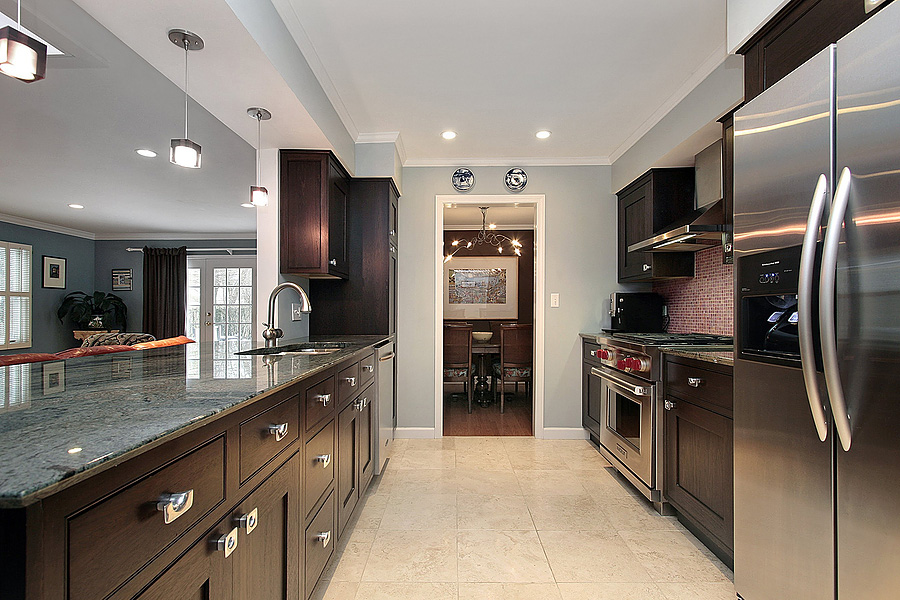“Three rules of work: Out of clutter find simplicity, from discord find harmony, in the middle of difficulty lies opportunity.”
— Albert Einstein
Given the number of organising tools on the market that are directed at kitchen storage, we should all have überorganised kitchens that are blissful places in which to work. However, real life sometimes gets in the way of creating the perfect kitchen, so we need to find a way to create a functional space that will inspire us to get into the kitchen and make good use of the space, regardless of what we have to work with.
Assess
When organising a kitchen, it’s critical to assess the storage space you have available. Grab some paper and a pencil and sketch your kitchen. Allocate cupboard space to like items and make sure you have homes for everything. It’s important to keep your cupboards ordered and to put things back in their place. If you’ve ever had visitors pack away your washing up, you’ll know how frustrating it is not to know where your baking tray is — only to find it hiding next to a saucepan in the small appliance cupboard.
There are no hard-and-fast rules for how much room you need to allocate to each kind of item — it will depend on what you own and how you use your kitchen. If you have young kids, you may want to allocate a drawer or cupboard to plastic plates and cups, but if you entertain a lot, that same space might be filled with serving platters. If you decorate cakes, you’re going to need more space for your supplies than someone who whips together a packet cake only on birthdays.
When you’re planning what to put where, there are a few general guidelines. The most frequently used items should occupy prime real estate; high cupboards should be reserved for items you only use a few times a year. Also, make sure cupboards or drawers are easily accessible when you’re cooking or serving food, or emptying the dishwasher — if the dishwasher obstructs a cabinet when it’s opened, that’s not where you want to put your everyday dishes.
Sometimes, no matter how organised you are, there simply isn’t enough cupboard space. And if there’s no hope of a kitchen renovation in the near future, you need to get creative. We are accustomed to fixed cabinetry in modern Australian kitchens, but this doesn’t have to be the case. If you’re short on storage space, don’t hesitate to bring in a bookshelf for bulky items and appliances, or a hanging ladder for pots and pans. An island butcher block can add workspace and storage. Use furniture designed for other rooms in the house for kitchen storage if it helps you stay organised.
Declutter
Regardless of how much storage space you have, it’s important to keep it uncluttered. Go through your cupboards and declutter ruthlessly. If you don’t use it or it is a spare, can you get rid of it? If you have containers without lids and random lids floating around, they are as good as useless. Mismatched plates you never use don’t need to be kept. Go through your kitchen towels and dishcloths and throw out those that are wearing out or are badly stained. If you can pare down and simplify your kitchen contents, it makes it far easier to keep it clean and organised.
It also makes the cooking process simpler, and you’re far more likely to find that you have enough storage space after all. It’s especially important to keep kitchen benchtops decluttered and tidy. Make sure items that don’t belong in the kitchen don’t get the opportunity to take up residence, and put away kitchen items after you use them to keep them off the bench. It’s always easier to cook if you have enough bench space to work comfortably.
Bring in inspiration
All this talk of organisation may sound very clinical and mundane, but this is the foundation. Now that you have a healthy foundation, you can decorate to make the kitchen gorgeous and inspiring. Spending time in the kitchen will always be more fun if the space is warm and inviting, so decorate with your family’s happiness in mind.
Use your best tea-towels and pot holders and make a display of them. Paint a feature wall in your favourite colour or add a vibrant tile feature to bring interest to your kitchen without breaking the bank. If you have a kitchenalia collection, such as enamelware or rolling pins, put it on display and use it. If you love fresh flowers, use cut blooms to add colour and fragrance to your kitchen. If you love to try new recipes, keep your cookbook collection handy so you can access it when inspiration strikes.
Remember to strike that balance between functional and fabulous and make sure your decorating touches don’t make it harder to complete your everyday cooking tasks. If the glass jug collection takes up a quarter of the benchtop, you’d be better off finding a shelf somewhere else to display it.
The primary function of a kitchen is to provide a meal preparation zone, so it needs to be organised — but this doesn’t mean it also has to be devoid of personality.






